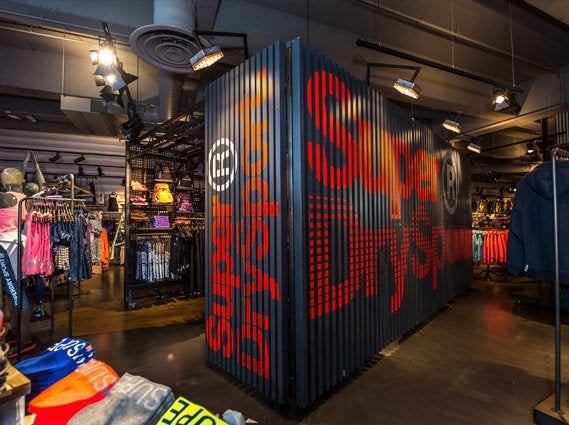
UK clothing retailer Superdry has reported that its half year (H1) total group revenue fell by 11% to £359.1m from £414.6m the previous year in its interim results for the 26 weeks ending 26 October 2019.
The company said the drop reflects an expected year of reset, with declines across all of its channels, as it addresses a number of legacy issues across the business.
Retail revenue fell 11.4% to £215.1m from £242.8m, with both e-commerce revenue and store revenue falling 10.7% and 11.7%, respectively.
Wholesale revenue fell 10.4% to £154m from £ 171.8m and gross profit declined 11.1% to £207.8m from £233.7m.
The retailer said the revenue decline in wholesale is due to the impact of a previous retail strategy of heavy discounting and lower-quality product, as well as a change to align deliveries of forward order product to the requirements of its wholesale customers, rather than its reporting calendar.
Underlying profit before tax decreased 117.8% to £2.3m from £12.9m and underlying operating profit fell 91.3% to £1.3m from £14.9m.
Superdry founder and chief executive officer Julian Dunkerton said: “At this halfway point in our financial year, I am pleased with the progress we have made to comprehensively reset Superdry. We’re doing this through our product and brand, our physical and digital retail operations and a renewed focus on the retailing basics.
“We are only eight months into a process that will take two to three years, but I have great confidence in the strength of our new executive leadership team. I am also pleased with the trajectory of performance we have seen from Q1 to Q2 and subsequently into our peak trading period, which gave us our biggest online trading day ever. However, we remain cautious about the challenging market conditions over the peak trading period.”
In July this year, the retailer reported an £85.4m statutory loss in profit before tax in its full-year results to 28 April 2019, after reporting a profit of £65.3m the previous year.
Analysts urge Superdry to find ways to futureproof brand
GlobalData retail analyst James Yacoub said: ‘‘CEO Julian Dunkerton has been given until April 2021 to implement his turnaround plan and steady the Superdry ship, as it deals with legacy issues and tackles its brand perception problem. Its H1 results show little concrete evidence of improvements so far, with group revenue down £45.5m to £369.1m with declines across all channels, and an underlying operating margin of just 0.4%, down 320 basis points (bps) on the year.
“Dunkerton insists that good progress has been made in implementing his transformation plan, with store performance improving in Q2 as revamped product hit down and the focus shifting to more restrained promotional activity, leading to the full price retail sales mix increasing to 70% versus 52% last year. However, in order to prove Superdry’s strategy is the right one, the retailer needs to demonstrate positive revenue results in the long term.
“Superdry continues to slip behind competitors who have far more refined propositions and are more in tune with their customers’ needs. JD Sports, for example, has remained relevant to its core customer base by continuing to stock the latest and most popular athleisure brands, as well as partnering with prominent influencers. Effectiveness of its strategy is reflected in its H1 2019 results (for the 26 weeks ending 3 August) in which it achieved 10% like-for-like revenue growth.”
Yacoub continued: “In Superdry’s FY2018/19 update, Dunkerton announced his transformation plan to bring back design excellence and restore store profitability. This, whilst simultaneously implementing its strategy of reducing promotional activity and driving full price sales, will prove to be an arduous task. As Superdry attempts to reignite its brand appeal, it should focus on updating its style credentials and also highlight its high-quality materials. It must now find a way to futureproof the brand.
“Positive steps have been taken in hiring ex-Nike executive Phil Dickenson as creative director, who can breathe new life into the business and potentially help restore Superdry’s long lost ‘cool factor.’ This will, however, be no easy task and will require loosening the purse strings on the marketing budget – an effective marketing campaign is much needed to help transform Superdry’s brand perception.
“While Superdry states that early Q3 trading has been encouraging, with a standout online performance on Black Friday, Dunkerton remains cautious about Superdry’s potential over peak Christmas trading and the rest of H2. Rightly so, as the brand attempts a transformational comeback amid one of the most challenging retail periods, with the added difficulty of weaning itself off the relentless promotional cycle many have been forced to adopt requiring a need to justify its full price proposition.”



